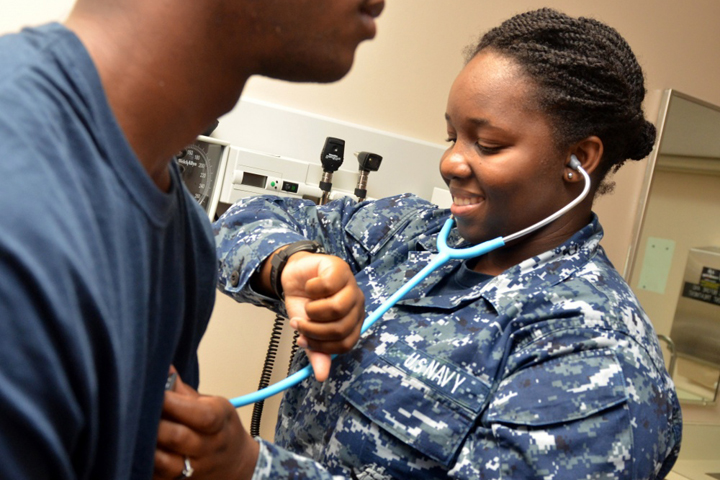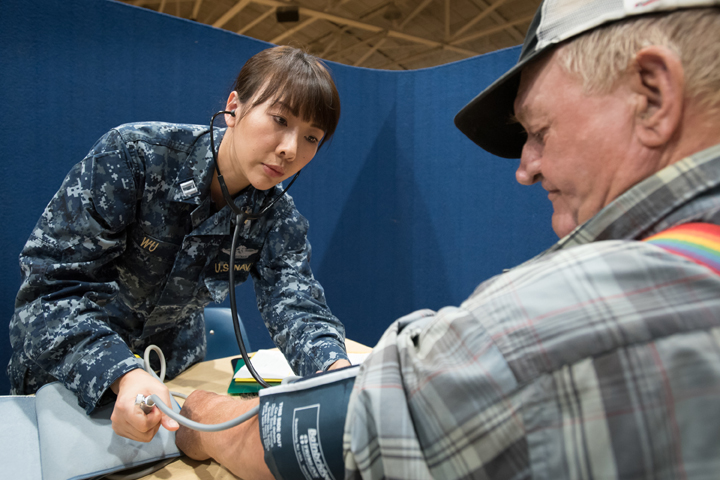
Experts dish out 9 tips for heart health

Naturally occurring phytochemicals in plants provide color, aroma, and flavor to fruits and vegetables. Different colors provide different nutrients, so eating a range of colors is essential for heart health. (U.S. Air Force illustration by Airman 1st Class Jennifer Gonzales)
Earlier this month, the Military Health System showed how Total Force Fitness keeps the hearts of the armed forces healthy and ready to defend the nation. The MHS sat down with Karen Hawkins, a dietician with Military Community and Family Policy, and Patricia Deuster, Ph.D., director of the Consortium for Health and Military Performance at the Uniformed Services University of the Health Sciences, to offer the dish on heart health and provide a few helpful hints to improve yours:
Introduce some color to your diet.
Phytochemicals naturally occurring chemicals in plants provide fruits and vegetables with color, smell, and flavor. Different colors provide different nutrients, so eat a range of colors for maximum benefit.
Deuster Dish: “Aim to fill half your plate with colorful vegetables and enjoy fruit for dessert and as part of your snack. Pick one new fruit or vegetable each week to try – this is a great way to introduce your family to new fresh and healthy foods.”
Cook more at home.
Families who cook at home have control over the ingredients, portions, and cooking process. Also, meals at home can be cheaper than dining out. Home cooking is associated with higher-quality diets, better weight management, and improved health.
Deuster Dish: “This is a great way to spend time with family and friends. Many military installations offer cooking classes and programs, so learn new recipes and try them at home with the family.”
Talk to a registered dietitian or nutritionist about an eating plan.
It’s a challenge for health care providers to tell warfighters and their families what the best diet is for heart health because individual preferences and differences in metabolism will determine what diet will last long term.
Hawkins Hint: “Following a plant-based diet, Mediterranean diet, or dietary approaches to stop high blood pressure or ‘DASH’ diet can help with preventing heart disease and reduce risk of heart complications. Talk to a registered dietitian or nutritionist to find out which plan works best for you.”
Eat foods rich in Omega-3.
Omega-3 fats help reduce blood pressure, abnormal heart rhythms, and the risk of stroke and heart failure. The human body does not produce omega-3 fats on its own, so eating foods with that type of fat can help improve heart health.
Deuster Dish: “Although foods like fish, flax, and chia seeds are the best source of omega-3s, some people take dietary supplements which, if chosen correctly, could be helpful.”
Check the ingredients in dietary supplements.
Some dietary supplements contain stimulants that can have adverse effects on the heart, like rapid heart rate and abnormal rhythms that can contribute to heart attack and stroke.
Deuster Dish: “Check your dietary supplements for stimulants or other ingredients that might ‘over activate’ your heart.”
Get a pet, and take it on walks.
According to the Centers for Disease Control and Prevention, regular walking or playing with pets can decrease blood pressure, cholesterol levels, and triglyceride levels, all which affect the heart. Pets can also help manage loneliness and depression. They provide companionship and opportunities to socialize with others during play activities like dog walks.
Learn more about the benefits of dog walking on the heart and other domains of Total Force Fitness at Health.mil.
Do a “chill drill.”
Mental stress can be seen physically through symptoms like increased blood pressure, and perhaps indirectly through unhealthy behaviors like smoking, excess drinking, and poor food choices.
Hawkins Hint: “Take up meditation or deep breathing to help deal with stress. Military OneSource also offers ‘chill drills’ to help develop meditation habits and breathing exercises.”
Become financially fit.
Financial stress can mess up more than the checkbook. It can damage heart health by adding stress on the heart. Financial fitness also touches more than one domain of Total Force Fitness, affecting both the body and mind.
Hawkins Hint: “Financial counseling, or just evaluating how you stand with financial fitness, can help to reduce the stress associated with financial woes and lead to less strain on the heart. You can find more resources on how to evaluate your financial fitness on Military OneSource.”
Quit smoking.
Seriously. Tobacco use is linked not only to heart disease, but lung disease and numerous other health risks. With the rise in popularity of e-cigarettes, vapes, and smokeless tobacco, it’s important to remain educated about the negative effects of tobacco use.
Visit Health.mil to learn more about how the Total Force Fitness framework is helping to raise awareness about tobacco facts, and to discover some best practices for quitting.
Listen to your heart in February with Total Force Fitness
Article
2/6/2020

Heart health is key to a medically ready military force; the Military Health System looks at this subject through the Total Force Fitness framework
MHS raises awareness of heart health on National Wear Red Day
Article
2/4/2020

Dress for success (a healthy heart) Friday Feb. 7
Is exercise that’s too intensive resulting in your angina?
Article
4/8/2019

Angina is experienced as a feeling of tightness or pressure in the chest that can also radiate out to your neck, jaw, back or shoulders
Sudden cardiac death in young athletes
Article
3/7/2019

Sudden cardiac events can occur in seemingly healthy young people in their teens or twenties, including young servicemembers
Too much pressure: Hypertension a leading cause of heart disease
Article
3/5/2019

Healthy lifestyle now can help prevent disorder later
Focus on heart-healthy diet is perfect fit for February
Article
2/22/2019

With the typical American diet and lifestyle, many people put themselves at risk for developing various heart diseases
Taking care of your heart with TRICARE benefits
Article
2/19/2019

Getting preventive screenings now could save your life tomorrow
Deep vein thrombosis: What you need to know
Article
4/9/2018

Everyone’s potentially at risk, vascular surgeon says
Small changes, big results: Healthy lifestyle choices can make a difference for heart health
Article
4/6/2018

Risk for heart disease, the number one killer of Americans every year, can be decreased through healthy lifestyle and nutrition choices
Parents and doctors watch over a tiny heart
Article
3/19/2018

A military family’s rocky medical road with congenital heart disease
Absolute and Relative Morbidity Burdens Attributable to Various Illnesses and Injuries, Active Component, U.S. Armed Forces, 2016
Infographic
6/19/2017

This infographic documents healthcare burdens attributable to cardiovascular diseases among active component, U.S. Armed Forces in 2016.
Heart Disease and Its Effects on Service Members
Infographic
6/8/2016

Cardiovascular disease comprises disorders of the heart and circulatory system including coronary heart disease and cerebrovascular disease. This infographic provides data on the risk factors for cardiovascular disease among military members base on diagnostic codes in the electronic health records of service members during a 10-year surveillance period.
The ABC's of Heart Health
Infographic
2/22/2016

Bring awareness to the risks of heart disease and ways to stay heart healthy.
Take Charge of Your Heart Health
Infographic
2/16/2016

Take Charge of Your Heart Health with Regular Checkups
Keep Your Heart Healthy This Valentine's Day
Infographic
2/11/2016

4 ways to keep your heart healthy this Valentine's Day






















.png)











No hay comentarios:
Publicar un comentario